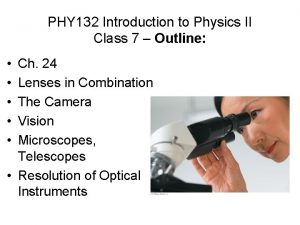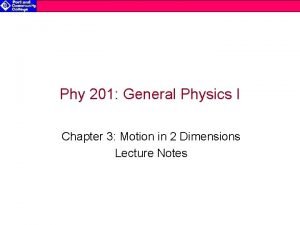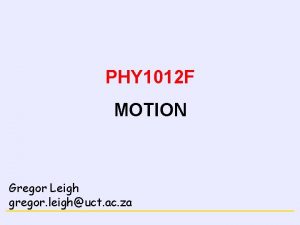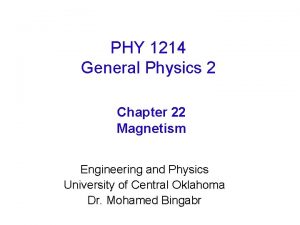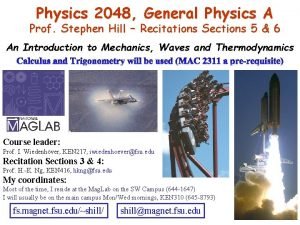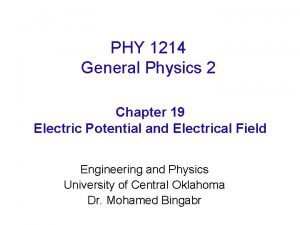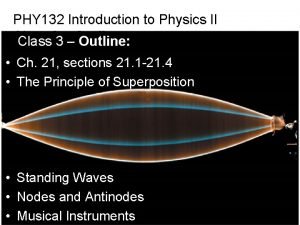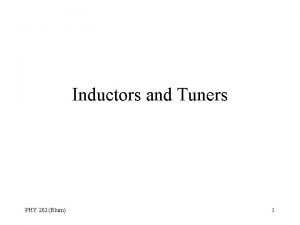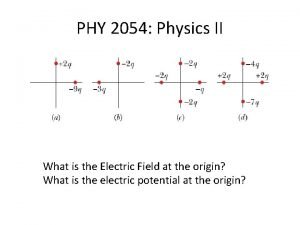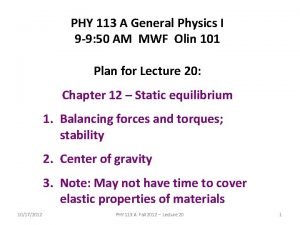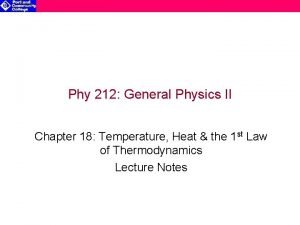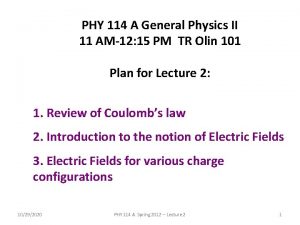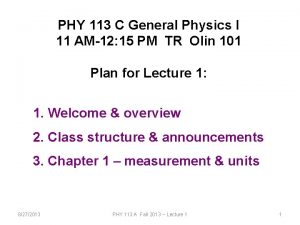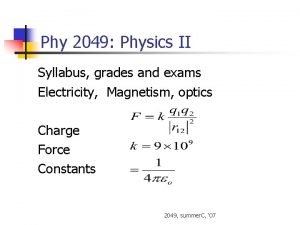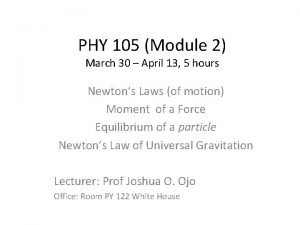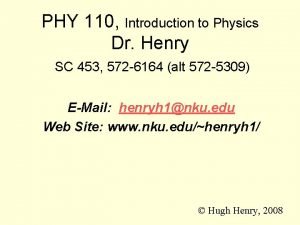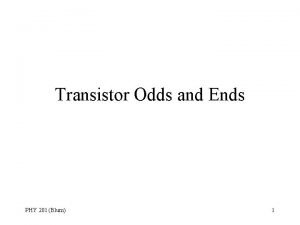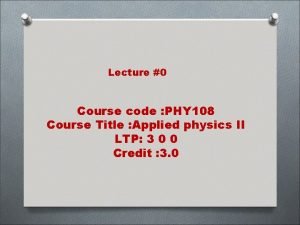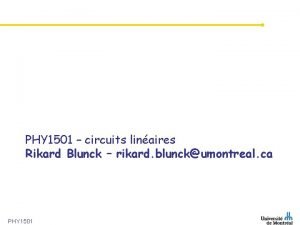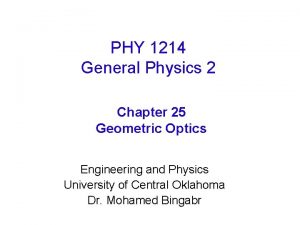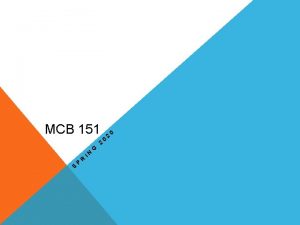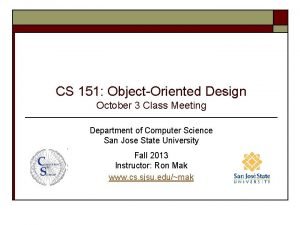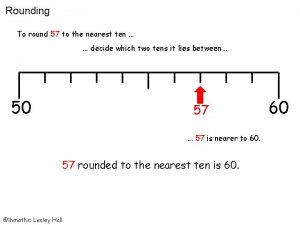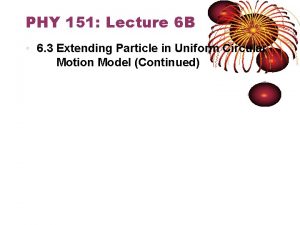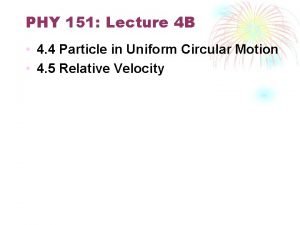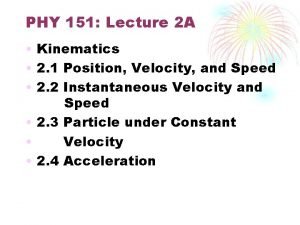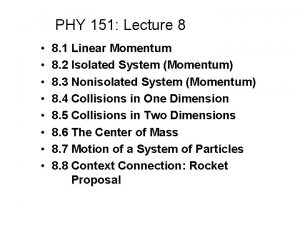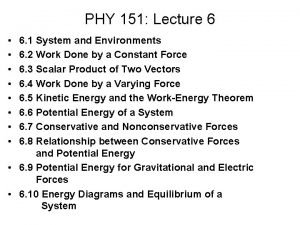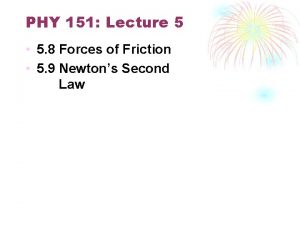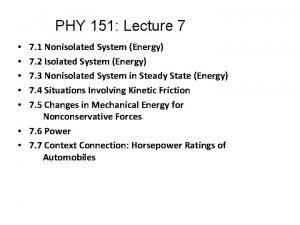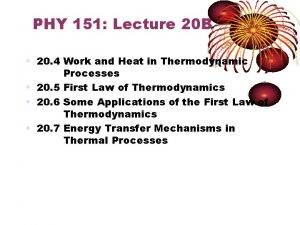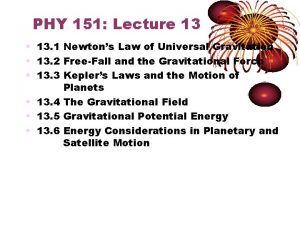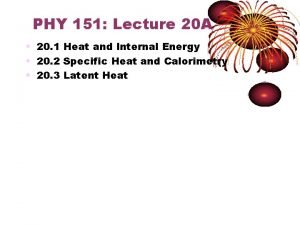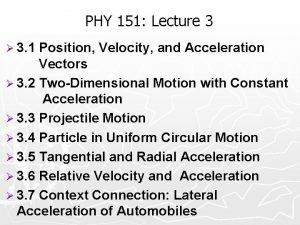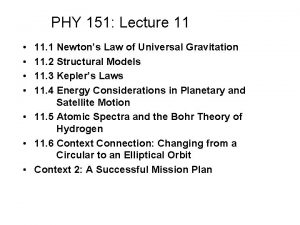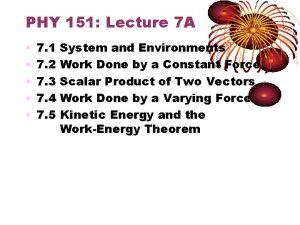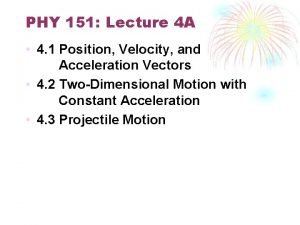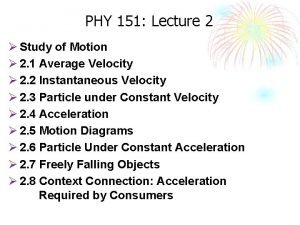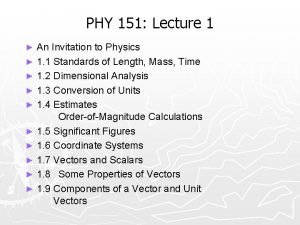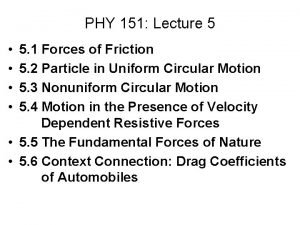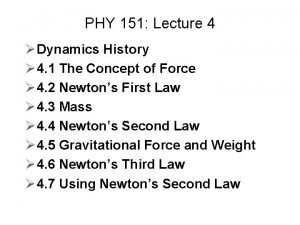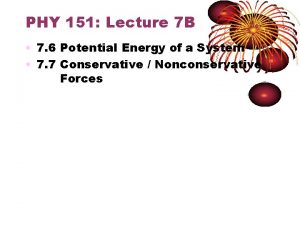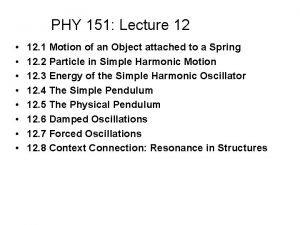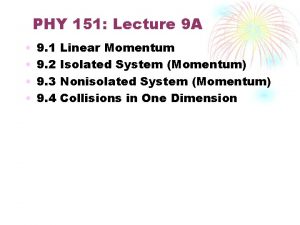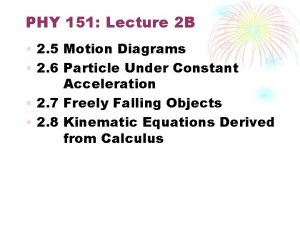PHY 151 Lecture 6 6 3 Extending Particle














































- Slides: 46

PHY 151: Lecture 6 • 6. 3 Extending Particle in Uniform Circular Motion Model (Continued) • 6. 4 Nonuniform Circular Motion • 6. 5 Motion in Accelerated Frames • 6. 6 Motion in Presence of Resistive Forces

PHY 151: Lecture 6 Circular Motion Other Applications of Newton’s Laws 6. 3 Extending Particle in Uniform Circular Motion Model (Continued)

Gravitron - 1 • Circular room with a person pressed against the wall • What is ms to keep the person from sliding down? • Radius is 3 meters • Rotating at 20 revolutions/minute

Gravitron - 2 • v = 20 rpm = 20 x 2 pr/60 m/s • v = 20 rpm =2. 09(3) = 6. 28 m/s • Friction force = weight • ms. N = mg • Normal force is centripetal force • Fc = N = mv 2/r • msmv 2/r = mg • ms = gr/v 2 = (9. 8)(3)/6. 282 = 0. 76

Satellites in Uniform Circular Motion

Centripetal Force Satellites in Orbit - 1 • Satellite of mass m is in orbit around earth • Gravitational pull of earth provides centripetal force ØFc = GMem/r 2 = mv 2/r ØGMe/r = v 2 Øv = sqrt(GMe/r) • Orbital velocity for a given radius is independent of mass of satellite

Centripetal Force Satellites in Orbit - 2 • • • v = sqrt(GMe/r) (from prior slide) v = 2 pr/T (definition of period) 2 pr/T = sqrt(GMe/r) T 2 = 4 p 2 r 3/Gme r 3 = T 2 Gme/4 p 2 Relationships between period, T, and orbital radius r

Low Earth Orbit - 1 • • • Velocity of a satellite in low earth orbit Me = 5. 98 x 1024 kg re = 6. 37 x 106 m Height of satellite = 120 miles = 0. 19 x 106 m rorbit = 6. 56 x 106 m G = 6. 67 x 10 -11 nm 2/kg 2 v = sqrt(GMe/r) v = sqrt(6. 67 x 10 -11 x 5. 98 x 1024/ 6. 56 x 106) v = 7797 m/s = 17, 446 mi/hour

Low Earth Orbit - 2 • • • Period of satellite in low earth orbit T 2 = 4 p 2 r 3/Gme re = 6. 38 x 106 m Height of satellite = 120 miles = 0. 19 x 106 m rorbit = 6. 56 x 106 m me = 5. 98 x 1024 kg T 2 = 4 p 2(6. 38 x 106)3/[6. 673 x 10 -11 x 5. 98 x 1024] T 2 = 27941796 s 2 T = 5286 s = 88 minutes

Geosynchronous Orbit - 1 • A satellite in geosynchronous orbit stays above a specific place on the earth • For this to occur, the period of the orbit must be 24 hours = 86400 s • r 3 = T 2 Gme/4 p 2 • r 3 = (86400)2 x [6. 673 x 10 -11 x 5. 98 x 1024] /4 p 2 • r 3 = 7. 55 x 1022 m 3 • r = 4. 23 x 107 m = 26, 268 miles • This is distance from center of the earth

Geosynchronous Orbit - 2 • • • r = 4. 23 x 107 m = 26, 268 miles This is distance from center of the earth Radius of earth is 6. 38 x 106 m Distance from surface is 4. 23 x 107 – 0. 64 x 107 = 3. 59 x 107 m 22, 312 miles

Satellites in Orbit – Example 3 • • Earth orbits the sun as a satellite. What is sun’s mass? Distance from earth to sun, rse = 1. 5 x 1011 m Period of earth around sun Ø T = 365. 24 days x 24 x 60 = 3. 156 x 107 s • • d = vt v = d/t = 2 prse /T GMsun/rse = v 2 = 4 p 2 rse 2/T 2 Msun = 4 p 2 rse 3/GT 2 Msun = 4 p 2(1. 5 x 1011)3/6. 67 x 10 -11/(3. 156 x 107)2 Msun = 2 x 1030 kg Msun/Mearth = 2 x 1030 / 6 x 1024 = 330, 000

Satellites in Orbit – Example 4 • • • Moon is satellite of Earth Io is satellite of Jupiter What is ratio of Jupiter’s mass to earth’s mass Period, Tmoon , of the moon is 27 days Period, Tio, of Io is 1. 5 days Radii of the moon and Io are approximately the same • Mearth = 4 p 2 rme 3/GTmoon 2 • Mjupiter = 4 p 2 rij 3/GTio 2 • Mjupiter/Mearth = Tmoon 2/Tio 2 = (27/1. 5)2 = 324

Satellites in Orbit – Example 5 • • • Earth and Jupiter are satellites of the sun What is ratio of Jupiter’s period to earth’s period 1 AU = 1. 5 x 1011 m, distance from earth to sun Earth’s distance from sun is 1 AU (astronomical unit) Jupiter’s distance from sun is 5. 2 AU Msun = 4 p 2 rse 3/GTearth 2 = 4 p 2 rse 3/GMsun Tjupiter 2 = 4 p 2 rsj 3/GMsun Tjupiter/Tearth = sqrt(rsj 3/rse 3) = sqrt(5. 23/13) = 11. 86

Stars Orbiting Edge of Galaxy - 1 • Mass of galaxy is 2 x 1041 kg • This is the mass of visible stars and dust • A star orbits the galaxy at 2. 7 x 1020 m from the center of the galaxy • This is close to the edge of the galaxy • Assume 90% or more of the galactic mass is inside the star’s orbit • Find a formula for the orbital velocity of star’s at the edge of the galaxy

Stars Orbiting Edge of Galaxy - 2

Graph

Actual Data Rotation curve of a typical spiral galaxy: predicted (A) and observed (B). The discrepancy between the curves is attributed to dark matter.

PHY 151: Lecture 6 Circular Motion Other Applications of Newton’s Laws 6. 4 Nonuniform Circular Motion

Non-Uniform Circular Motion • The acceleration and force have tangential components • produces the centripetal acceleration • produces the tangential acceleration • The total force is •

Vertical Circle with Non-Uniform Speed • The gravitational force exerts a tangential force on the object – Look at the components of Fg • Model the sphere as a particle under a net force and moving in a circular path – Not uniform circular motion • The tension at any point can be found

Top and Bottom of Circle • The tension at the bottom is a maximum • • The tension at the top is a minimum • If Ttop = 0, then

PHY 151: Lecture 6 Circular Motion Other Applications of Newton’s Laws 6. 5 Motion in Accelerated Frames

Motion in Accelerated Frames • A fictitious force results from an accelerated frame of reference – The fictitious force is due to observations made in an accelerated frame – A fictitious force appears to act on an object in the same way as a real force, but you cannot identify a second object for the fictitious force • Remember that real forces are always interactions between two objects – Simple fictitious forces appear to act in the direction opposite that of the acceleration of the non-inertial frame

“Centrifugal” Force • From the frame of the passenger (b), a force appears to push her toward the door • From the frame of the Earth, the car applies a leftward force on the passenger • The outward force is often called a centrifugal force – It is a fictitious force due to the centripetal acceleration associated with the car’s change in direction • In actuality, friction supplies the force to allow the passenger to move with the car. – If the frictional force is not large enough, the passenger continues on her initial path according to Newton’s First Law

“Coriolis Force” • This is an apparent force caused by changing the radial position of an object in a rotating coordinate system • The result of the rotation is the curved path of the thrown ball • From the catcher’s point of view, a sideways force caused the ball to follow a curved path

Fictitious Forces, examples • Although fictitious forces are not real forces, they can have real effects • Examples: – Objects in the car do slide – You feel pushed to the outside of a rotating platform – The Coriolis force is responsible for the rotation of weather systems, including hurricanes, and ocean currents

Fictitious Forces in Linear Systems • • The inertial observer models the sphere as a particle under a net force in the horizontal direction and a particle in equilibrium in the vertical direction The non-inertial observer models the sphere as a particle in equilibrium in both directions The inertial observer (a) at rest sees • The non-inertial observer (b) sees • These are equivalent if Ffictiitous = ma •

PHY 151: Lecture 6 Circular Motion Other Applications of Newton’s Laws 6. 6 Motion in the Presence of Resistive Forces

Motion with Resistive Forces • Motion can be through a medium – Either a liquid or a gas • The medium exerts a resistive force, , on an object moving through the medium • The magnitude of depends on the medium • The direction of is opposite the direction of motion of the object relative to the medium – This direction may or may not be in the direction opposite the object’s velocity according to the observer • nearly always increases with increasing speed

Motion with Resistive Forces, cont. • The magnitude of can depend on the speed in complex ways • We will discuss only two: – is proportional to v • Good approximation for slow motions or small objects – is proportional to v 2 • Good approximation for large objects

Resistive Force Proportional To Speed • The resistive force can be expressed as • b depends on the property of the medium, and on the shape and dimensions of the object • The negative sign indicates is in the opposite direction to

Resistive Force Proportional To Speed, Example • Assume a small sphere of mass m is released from rest in a liquid • Forces acting on it are: – Resistive force – Gravitational force • Analyzing the motion results in

Resistive Force Proportional To Speed, Example, cont. • Initially, v = 0 and dv/dt = g • As t increases, R increases and a decreases • The acceleration approaches 0 when R ® mg • At this point, v approaches the terminal speed of the object

Terminal Speed • To find the terminal speed, let a = 0 • Solving the differential equation gives • t is the time constant and • t = m/b

Resistive Force Proportional To v 2 • For objects moving at high speeds through air, the resistive force is approximately equal to the square of the speed. • R = ½ Dr. Av 2 – D is a dimensionless empirical quantity called the drag coefficient – r is the density of air – A is the cross-sectional area of the object – v is the speed of the object

Resistive Force Proportional To v 2, example • Analysis of an object falling through air accounting for air resistance

Resistive Force Proportional To v 2, Terminal Speed • The terminal speed will occur when the acceleration goes to zero • Solving the previous equation gives

Some Terminal Speeds

Example: Skysurfer • Step from plane – Initial velocity is 0 – Gravity causes downward acceleration – Downward speed increases, but so does upward resistive force • Eventually, downward force of gravity equals upward resistive force – Traveling at terminal speed

Skysurfer, cont. • Open parachute – Some time after reaching terminal speed, the parachute is opened – Produces a drastic increase in the upward resistive force – Net force, and acceleration, are now upward • The downward velocity decreases – Eventually a new, smaller, terminal speed is reached

Example: Coffee Filters • A series of coffee filters is dropped and terminal speeds are measured • The time constant is small – Coffee filters reach terminal speed quickly • Parameters – meach = 1. 64 g – Stacked so that front-facing surface area does not increase • Model – Treat the filter as a particle in equilibrium

Coffee Filters, cont. • Data obtained from experiment: • At the terminal speed, the upward resistive force balances the downward gravitational force • R = mg

Coffee Filters, Graphical Analysis • Graph of resistive force and terminal speed does not produce a straight line • The resistive force is not proportional to the object’s speed

Coffee Filters, Graphical Analysis 2 • Graph of resistive force and terminal speed squared does produce a straight line • The resistive force is proportional to the square of the object’s speed

Resistive Force on a Baseball – Example • • The object is moving horizontally through the air The resistive force causes the ball to slow down Gravity causes its trajectory to curve downward The ball can be modeled as a particle under a net force – Consider one instant of time, so not concerned about the acceleration • Analyze to find D and R
 Phy 132 lecture 10: ch30
Phy 132 lecture 10: ch30 01:640:244 lecture notes - lecture 15: plat, idah, farad
01:640:244 lecture notes - lecture 15: plat, idah, farad Accommodation eye
Accommodation eye Vx=vox+axt
Vx=vox+axt Complete motion diagram
Complete motion diagram Great orthogonality theorem
Great orthogonality theorem Atm basics
Atm basics Phy tgen
Phy tgen Applications of magnetism
Applications of magnetism Phy 121 asu
Phy 121 asu Physics 2048
Physics 2048 Phy 1214
Phy 1214 Phy 2049
Phy 2049 Phy 132
Phy 132 Felix connects a wire coil to an ammeter
Felix connects a wire coil to an ammeter Rotational statics
Rotational statics Phy
Phy 2012 phy
2012 phy Ddr phy architecture
Ddr phy architecture Examples of convection
Examples of convection Phy
Phy Phy 131 past papers
Phy 131 past papers Phy 1214
Phy 1214 Phy
Phy Phy theorem
Phy theorem Life phy
Life phy Phy 2049
Phy 2049 Phy-105 5 discussion
Phy-105 5 discussion Phy 205
Phy 205 General physics 1 measurements
General physics 1 measurements Phy 110
Phy 110 Pa msu
Pa msu Phy
Phy Phy
Phy Phy 108
Phy 108 Phy113
Phy113 Phy circuit
Phy circuit General physics
General physics Model netics
Model netics Econ 151
Econ 151 118/151
118/151 Item 151
Item 151 Mcb 317 uiuc
Mcb 317 uiuc Hino 151
Hino 151 Sjsu cs 151
Sjsu cs 151 Alan ableson queens
Alan ableson queens 151 to the nearest hundred
151 to the nearest hundred
